Whether you are developing a business management system or a new digital product to take to market, you can use several approaches to kick things off. This article compares the differences between proof of concept (PoC), minimum viable product (MVP), and full product when developing a software platform. The following are listed in order of complexity and effort...
There are some cases where you may want to jump right into a MVP but there is value in starting with a PoC to see if the assumptions you made and your natural bias (there's always a bias) are leading you down the right path.
Proof of Concept (PoC)
- A proof of concept, also known as a PoC, is a prototype that is developed to demonstrate the feasibility of a particular concept or idea.
- The primary goal of a PoC is to validate the product's technical feasibility and test its basic functionality.
- PoCs are typically developed with minimal resources and in a short timeframe. It's a way to make sure that an idea is feasible before investing a lot of time and resources into it.
- They are often used to test the waters, with potential investors or customers to gauge interest in the product. It's like an experiment to see if something is possible or if it can be used in a real-world situation.
- A PoC can be anything from an interactive wireframe to a mock-up, or feasibility study, etc.
Minimum Viable Product (MVP)
- An MVP is a version of a product with just enough features to test and gather feedback from early adopters.
- It's a way to test the market and validate an idea with the least effort and resources.
- MVPs are often developed with a limited budget and a relatively short timeframe.
- They are often used to test the market and gather data to inform future development. So, it's a good way to see if there is actually demand for what you're offering before investing more time and money into it.
Full Product
- A full product is a complete version of the product that includes all of the features and functionality that the final product will have.
- The main goal of a full product, is to deliver value to customers and generate revenue.
- Full products are typically developed with significant resource and in a relatively long timeframe.
- They are often used to build a sustainable business.
"Be stubborn on vision but flexible on details." - Jeff Bezos (Amazon)
Key Differences
Focus
- PoCs are focused on technical feasibility
- MVPs are focused on product-market fit
- Full products are focused on delivering value and generating revenue
Resources
- PoCs are developed with minimal resources and in a short timeframe
- MVPs are developed with a limited budget and in a relatively short timeframe
- Full products are developed with significant resources and in a relatively long timeframe
Intent
- PoCs are used to test the waters
- MVPs are used to test the market and gather data
- Full products are used to build a sustainable business
Deciding which type of product to develop is a critical decision that needs to be made early in the software development process. PoCs, MVPs, and full products have unique advantages and disadvantages, each serving a different purpose. Therefore, it is important to choose the right type of product based on the project's goals, the resources available, and the timeframe for development.
The real goal from a business perspective is risk mitigation. How many assumptions do you want to make, and how much do you want to spend to determine if your idea could work? If you think about it, even organizations like Facebook follow this process. It started very simply, and when people started using it, they added new features. Facebook's platform today doesn't resemble its first version, and that's the point.
Need some advice? We are happy to help.
